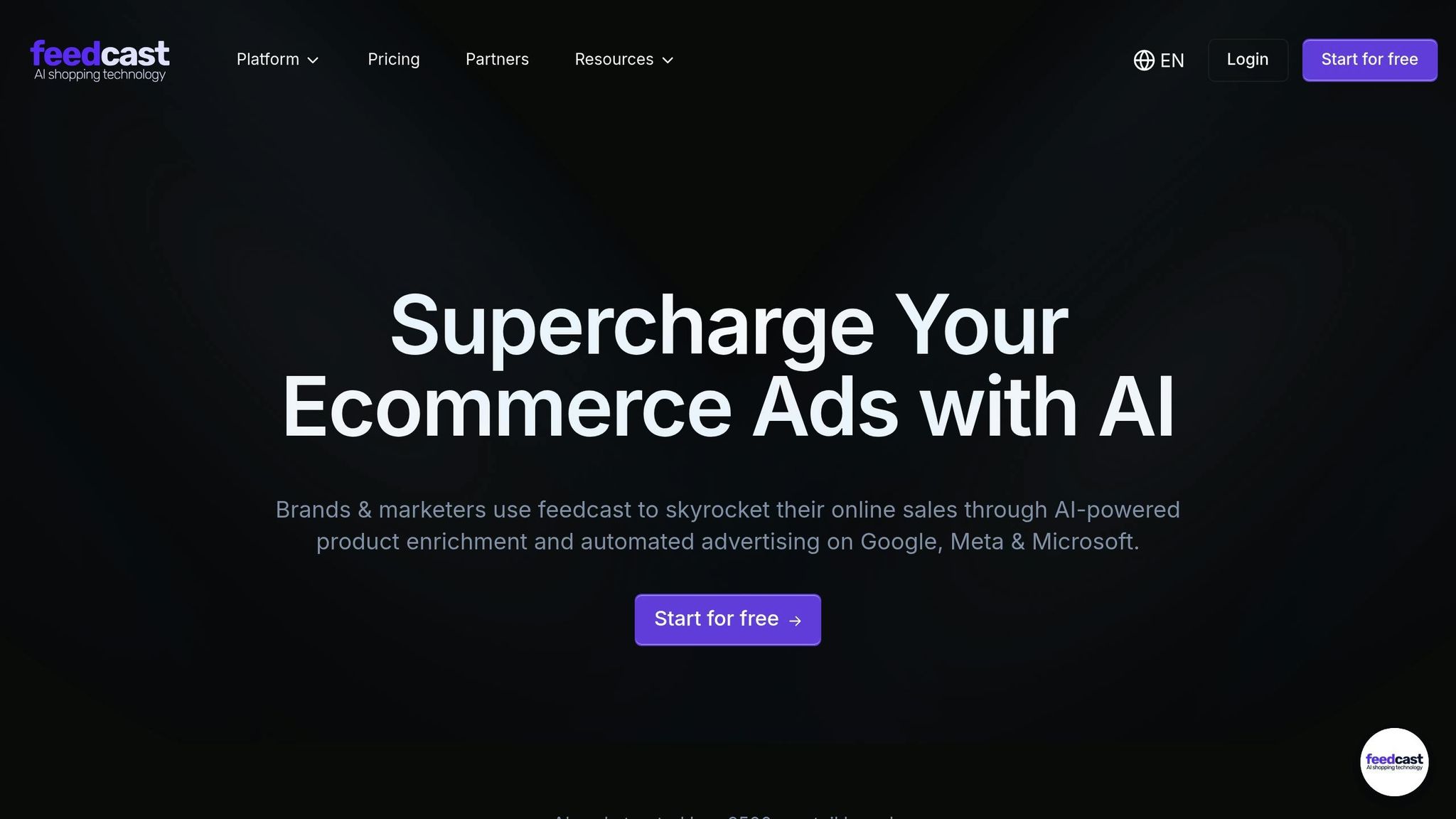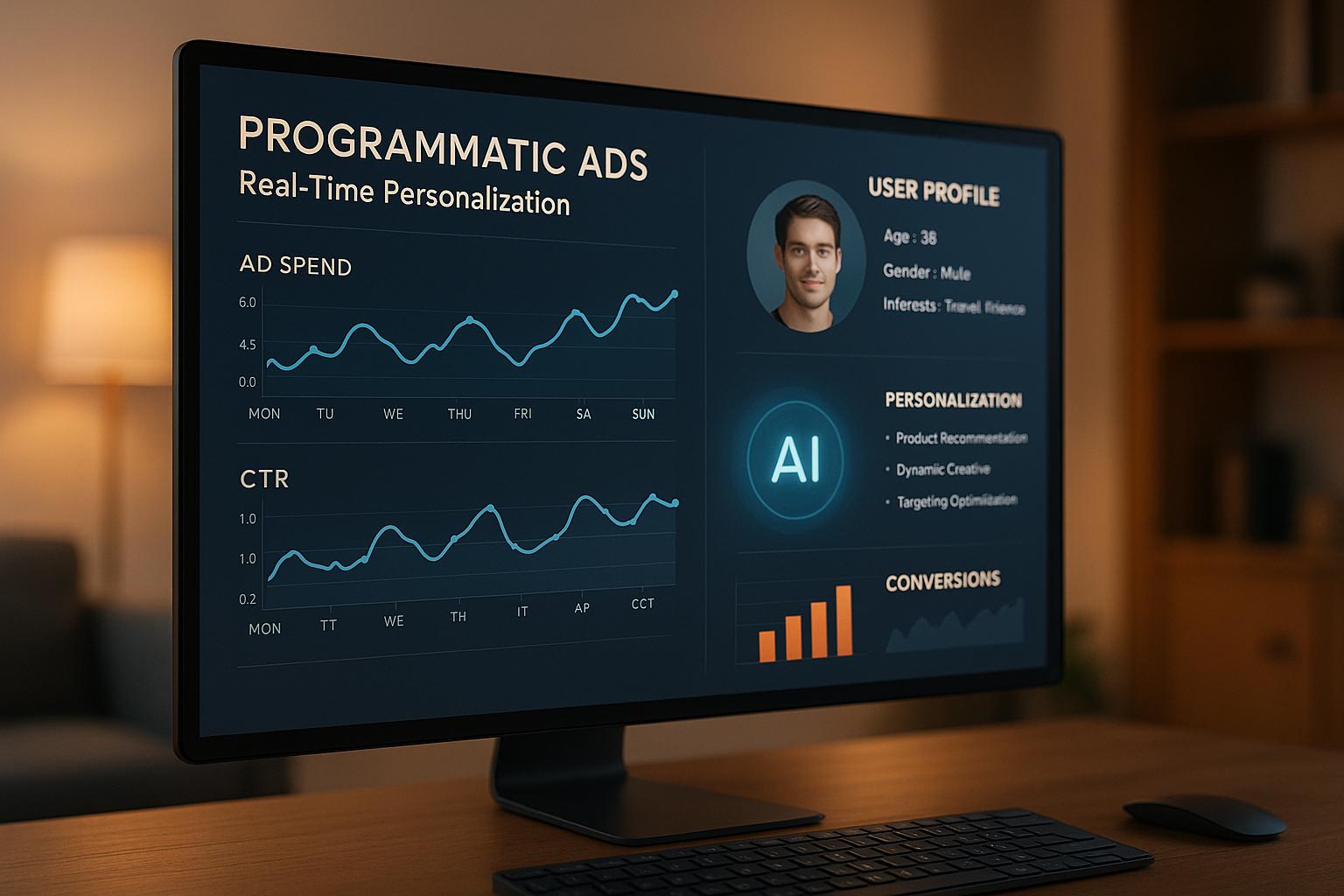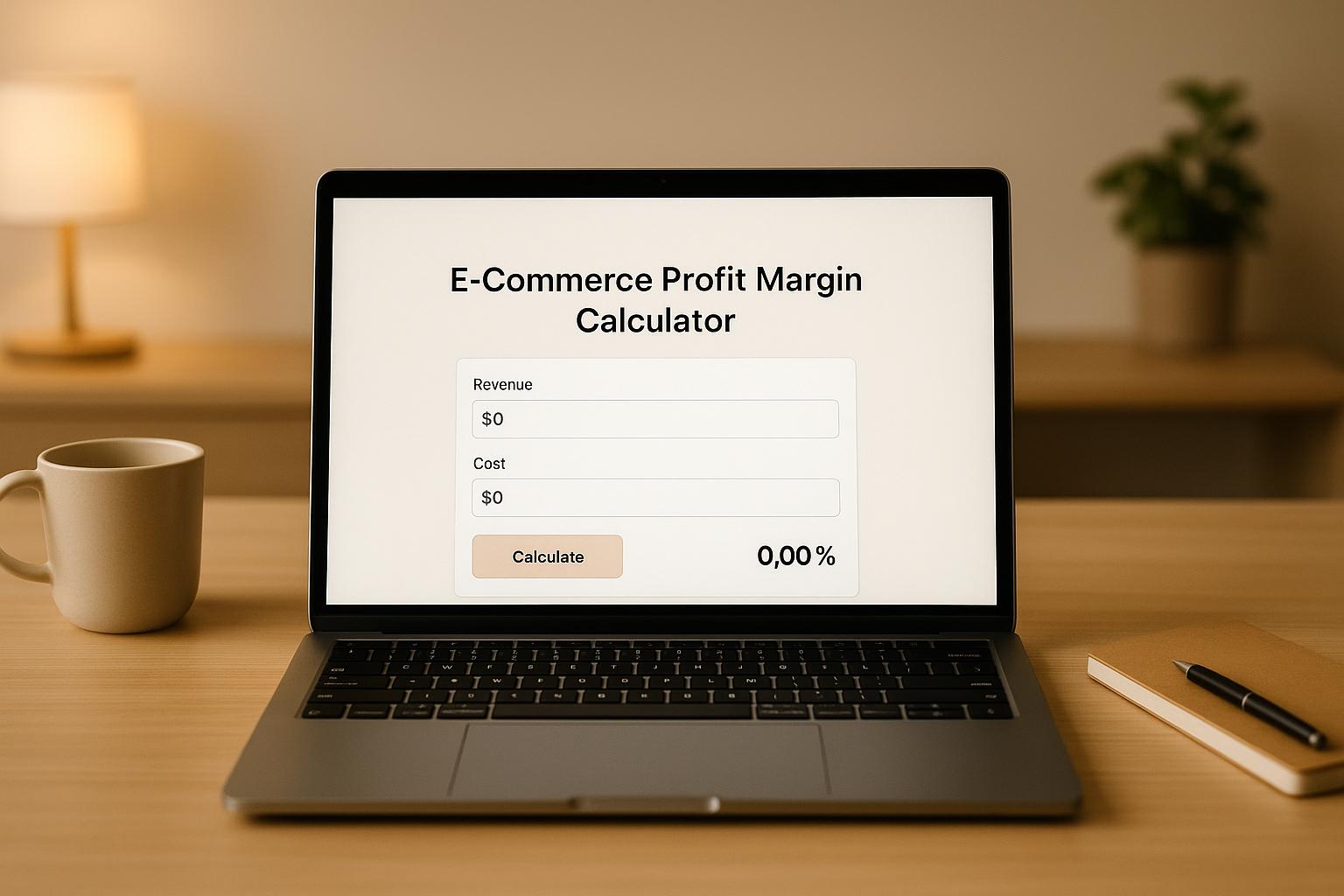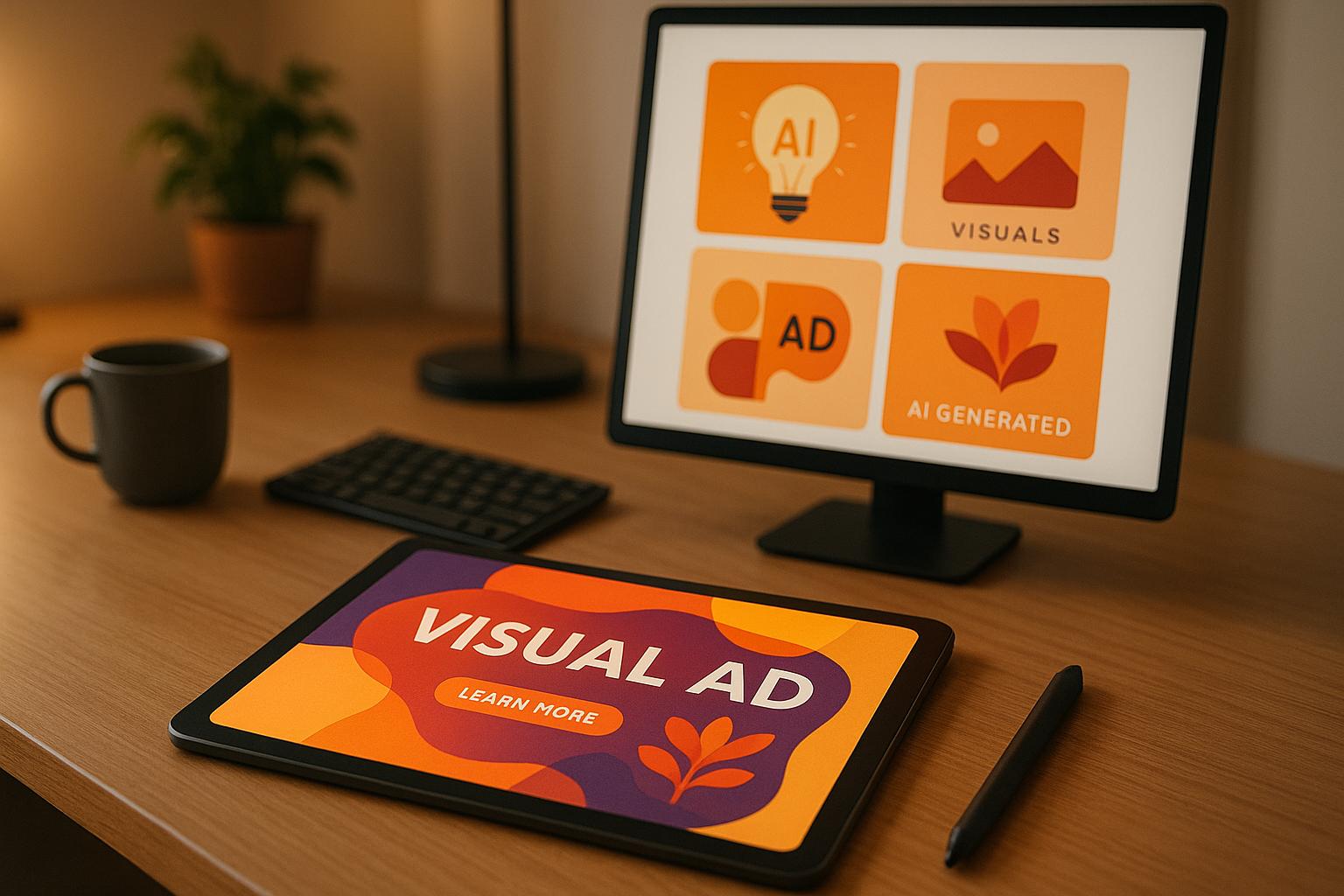AI-Powered A/B Testing for Faster Iterations
AI-powered A/B testing is transforming how businesses optimize their advertising campaigns. Unlike older methods that are slow and manual, AI automates the entire process - saving time, reducing errors, and delivering results faster. Here's why it matters:
- Speed: AI identifies winning ad variations in hours or days instead of weeks.
- Efficiency: It automates tasks like creating variations, analyzing data, and reallocating budgets.
- Smarter Insights: AI spots patterns, like peak performance times or audience preferences, that humans might miss.
- Scalability: Easily manage hundreds of tests across platforms like Google, Facebook, and Instagram.
For e-commerce, this means better ad performance, improved personalization, and higher ROI. Tools like Feedcast.ai simplify this by managing multi-channel campaigns, generating ad creatives, and providing real-time analytics - all in one place.
AI isn’t just making A/B testing faster - it’s making it smarter and more effective for businesses of all sizes.
Core Features of AI-Driven A/B Testing
AI-Powered Test Ideas
Traditional A/B testing often wastes time experimenting with random variables, hoping to stumble upon something impactful. AI changes the game by analyzing campaign data to identify the elements that actually move the needle on performance.
By examining patterns across successful campaigns, AI pinpoints key variables that are likely to drive improvements. For example, in e-commerce ads, AI might suggest testing different product images, headline variations, call-to-action buttons, or targeting parameters. It prioritizes these ideas based on their potential impact, ensuring that your efforts are focused on changes that matter most.
AI also dives into audience behavior to determine the best times to deliver your message. This eliminates the guesswork and directs your tests toward variations with the highest probability of success.
Automated Test Execution
Once AI has identified the most promising test ideas, it takes over the heavy lifting. Instead of relying on manual setups, AI automates the process, creating multiple ad variations, segmenting audiences, and managing traffic allocation to ensure statistically reliable results.
AI doesn't stop at a single platform - it coordinates tests across multiple channels like Google Ads, Facebook, and Instagram. This ensures consistency while tracking performance metrics specific to each platform.
The best part? Automated execution means tests can launch almost immediately. While traditional methods might take days or even weeks to implement, AI can roll out new tests within hours of spotting an opportunity. This speed allows for more frequent testing and faster optimizations compared to manual approaches.
Real-Time Adjustments and Multi-Armed Bandit Testing
After tests are launched, AI doesn’t simply sit back and wait for results. It actively fine-tunes campaigns in real time. Traditional A/B testing often requires running a test for a set period before analyzing results and selecting a winner. AI, however, uses a smarter approach called multi-armed bandit testing, which adjusts traffic allocation dynamically based on performance.
Here’s how it works: instead of evenly splitting traffic between variations throughout the test, AI gradually shifts more traffic to the better-performing versions as data comes in. At the same time, it continues collecting insights from underperforming variations. This approach maximizes your ROI while ensuring you don’t miss out on valuable learning opportunities.
With multi-armed bandit testing, you don’t have to wait weeks to see results. You can start reaping the benefits of improved performance within days - or even hours. AI keeps testing new variations in the background, but your budget increasingly flows toward the proven winners.
Another advantage of AI is its ability to minimize losses. Traditional testing forces you to spend equally on all variations, even after it’s clear that some aren’t working. AI quickly reallocates resources, cutting losses and maximizing exposure for your best-performing content.
When paired with AI’s pattern recognition capabilities, multi-armed bandit testing becomes even more powerful. AI can uncover subtle performance differences that might escape human analysts, such as how certain ad variations resonate with specific audience segments or perform better at particular times of day. These nuanced insights lead to smarter optimizations and more effective campaigns overall.
Accelerating A/B Testing & Experimentation with Generative AI Ft. Benjamin Skrainka from Amazon
Benefits of AI-Powered A/B Testing for E-Commerce
AI-powered A/B testing delivers tangible results, from speeding up test cycles to improving the return on your ad spend.
Faster Testing Cycles
Traditional A/B testing can drag on for weeks - or even months - while waiting for enough data to make reliable decisions. AI changes the game by cutting testing times by up to 50% compared to older methods[1]. How? It processes massive datasets quickly and adjusts in real time, shifting resources to winning variations as trends emerge. This means you can pinpoint what works faster, allowing you to make the most of your budget. Plus, the quicker turnaround opens up opportunities for more personalized ad strategies.
Better Targeting and Personalization
AI takes A/B testing to the next level with dynamic audience segmentation. It digs into user data - like demographics, browsing habits, and purchase history - to deliver the most relevant ad to each visitor[2]. This level of personalization can boost conversion rates by 10–30%, as it ensures the right message reaches the right person. For instance, AI might uncover that mobile users prefer video ads with captions, while desktop users respond better to detailed static images.
When Wayfair tested outdoor furniture ads on Facebook and Instagram, they found that a lifestyle image ad optimized with user engagement data led to 11% more clicks and 21% more conversions compared to a static image ad[4].
These personalized tweaks don’t just deliver short-term wins - they also build the groundwork for long-term, data-driven growth.
Data-Driven Insights and Performance Predictions
One of the standout perks of AI-powered A/B testing is its ability to uncover patterns and predict future outcomes. Instead of just showing past metrics, AI dives deeper, analyzing factors like customer lifetime value and retention rates to help drive sustainable growth[2]. It can even forecast seasonal trends and identify emerging audience segments, helping you prioritize experiments with the most potential.
This predictive power directly impacts your bottom line. AI-driven platforms can increase ROI on ad spend by 20–40% through real-time campaign optimization[3]. By pulling data from multiple channels, AI fine-tunes attribution models and budget allocation, ensuring maximum impact. And with each test cycle, the system learns and improves, creating a snowball effect that leads to consistently better advertising performance.
Setting Up AI-Driven Testing Strategies
Using AI for A/B testing isn’t just about running isolated tests - it’s about building a system that continuously learns and adapts. This kind of framework connects ongoing testing with automated management, making your campaigns smarter over time.
Continuous Testing for E-Commerce Ads
Traditional A/B testing often feels like a stop-and-go process: launch a test, wait for results, make changes, and repeat. AI flips the script by enabling always-on testing. Instead of testing one element at a time, AI can juggle multiple creative components - like headlines, images, call-to-action buttons, and audience segments - all at once. The system identifies what works, boosts the best performers, and phases out the weaker ones automatically.
The success of continuous testing hinges on setting clear goals from the start. Whether you’re aiming to improve click-through rates, conversion rates, or reduce cost per acquisition, defining these metrics ensures the AI focuses on what truly matters instead of chasing vanity metrics.
Best Practices for Test Timing
AI also changes how you approach test timing. Traditional methods often require long periods to gather enough data for statistically significant results. AI, on the other hand, can analyze real-time data to provide insights with smaller sample sizes. However, the ideal test length still depends on factors like traffic volume and conversion rates. For high-traffic campaigns, results might come quickly, while lower-traffic campaigns may need more time to gather meaningful data.
To avoid skewed results, steer clear of launching tests during major sales events or holidays. These periods often bring unusual traffic patterns that can distort insights. Additionally, after significant shifts in consumer behavior or traffic, give the system time to recalibrate before running new tests. This ensures your testing aligns with more stable conditions, complementing the continuous testing process.
Automated Test Management with AI
The real game-changer with AI-driven testing is automation. AI tools can manage the entire testing process - from creating and launching tests to pausing and optimizing them - without constant human intervention. This streamlines operations and keeps tests running smoothly.
With automated management, AI handles everything from generating test variations to reallocating budgets. By analyzing past performance, the system combines proven elements with fresh ideas to create new variations. It also dynamically shifts budgets toward top-performing tests while scaling back on underperformers, ensuring efficient use of resources.
Another advantage is anomaly detection. If a test starts behaving unexpectedly - like overspending without delivering results - the system can pause it, preventing wasted budget and keeping your strategy on track. This level of oversight ensures cleaner data and more reliable insights, ultimately helping you focus on the changes that drive the most impact.
sbb-itb-0bd1697
Feedcast.ai: A/B Testing for E-Commerce Campaigns

A/B testing powered by AI can be a game-changer, but its potential hinges on using the right platform. Feedcast steps in with multi-channel advertising tools and AI-driven optimization tailored for e-commerce businesses. By automating tedious workflows, Feedcast transforms how online retailers test and refine their campaigns, making iterative improvements faster and more efficient.
Multi-Channel Ad Management
Running A/B tests across multiple ad platforms can feel like juggling too many balls at once. Each platform has its own quirks, making consistent testing and comparison tricky. Feedcast simplifies this by bringing all your advertising accounts together in one place. Whether you’re using Google, Meta (Facebook and Instagram), or Microsoft Ads, you can manage everything through a single dashboard.
This unified approach makes A/B testing seamless. Instead of setting up similar tests on each platform manually, you can launch synchronized experiments with matching variables and timing across all channels.
For example, an online retailer might test two ad variations simultaneously on Google Shopping and Facebook Ads. Feedcast automatically allocates traffic between the two, tracks performance in real time, and adjusts budgets to favor the better-performing version. Along the way, it provides insights to help you fine-tune future campaigns[1]. This streamlined approach saves time and ensures precision, positioning Feedcast as a comprehensive solution for ad testing.
AI-Powered Ad Creation and Optimization
Creating ads manually can slow down the testing process. Feedcast eliminates this bottleneck with AI that generates tailored ad copy for each platform.
But it doesn’t stop at just writing text. Feedcast’s AI also segments audiences dynamically, using advanced targeting to refine groups and customize tests. This means your tests aren’t limited to comparing static ad versions - they’re evolving to match the preferences of different customer segments. By incorporating platform-specific adjustments, Feedcast ensures that your ads resonate with users based on their behavior on each channel.
Real-Time Analytics and Reporting
Speed matters in A/B testing, but only if you can act on insights quickly. Feedcast’s unified analytics dashboard pulls together data from all your ad channels, making it easy to make decisions without sifting through multiple reports.
The platform offers custom reports and detailed performance breakdowns, so you can understand why one variation outshines another. If a clear winner emerges early in your test, Feedcast’s AI can forecast long-term outcomes and flag potential issues before they escalate. This proactive approach helps you avoid wasting budget on underperforming ads while maximizing the effectiveness of your campaigns[1][2].
Conclusion and Key Takeaways
AI-powered A/B testing is reshaping how e-commerce campaigns are optimized. By automating tasks like hypothesis generation, test execution, and real-time analysis, it removes traditional bottlenecks in marketing workflows. The result? Faster testing cycles, sharper insights, and better ROI.
Evidence from real-world tests shows that AI-driven methods lead to higher click-through and conversion rates. These platforms make optimization more systematic and scalable, running continuous experiments across multiple channels without breaking a sweat.
One of AI's standout abilities is processing massive datasets in real time. It dynamically adjusts traffic allocation and identifies winning variants long before human analysts could spot the trends[5][3]. This not only minimizes human error and cognitive bias but also uncovers subtle patterns that manual methods might overlook[5].
Feedcast takes these benefits a step further by integrating AI-powered testing into its platform. With features like a unified dashboard, automated ad creation, and real-time analytics, Feedcast makes advanced testing accessible - even for smaller teams lacking deep technical expertise. It’s a game-changer for campaign management at any scale.
FAQs
How does AI-powered A/B testing make advertising campaigns faster and more efficient?
AI-Powered A/B Testing: Transforming Advertising Campaigns
AI-driven A/B testing is changing the game for advertising by automating the entire process and delivering instant insights. Unlike the old-school, manual methods that take up a lot of time, AI can test several ad variations at once, analyze customer behavior, and pinpoint the most effective option in no time.
This means businesses can fine-tune their campaigns faster, target audiences with greater precision, and roll out personalized ads on a large scale. By cutting down on the guesswork, AI-powered A/B testing enables smarter, data-driven decisions that can significantly enhance campaign performance and maximize ROI.
What is multi-armed bandit testing, and how can it improve A/B testing results?
Multi-armed bandit testing is a smarter way to run experiments. Instead of splitting traffic evenly like in traditional A/B testing, it uses an algorithm to adjust traffic in real-time, sending more visitors to the better-performing variations as the test unfolds.
This method helps you get faster results by cutting down the time spent on options that aren’t performing well. It’s a game-changer for industries like e-commerce, where quick decisions can make a big difference in both performance and revenue.
How does AI help e-commerce businesses create more effective and personalized advertising strategies?
AI is transforming how e-commerce businesses approach advertising by diving deep into customer data to reveal preferences, behaviors, and trends. With this insight, companies can create personalized ad content and run targeted campaigns that connect with specific audiences, boosting engagement and driving more conversions.
On top of that, AI-powered tools offer real-time performance analytics. This means businesses can tweak and fine-tune campaigns on the fly, keeping their marketing strategies sharp and effective. The result? Improved ROI and steady growth over the long haul.
Yohann B.




